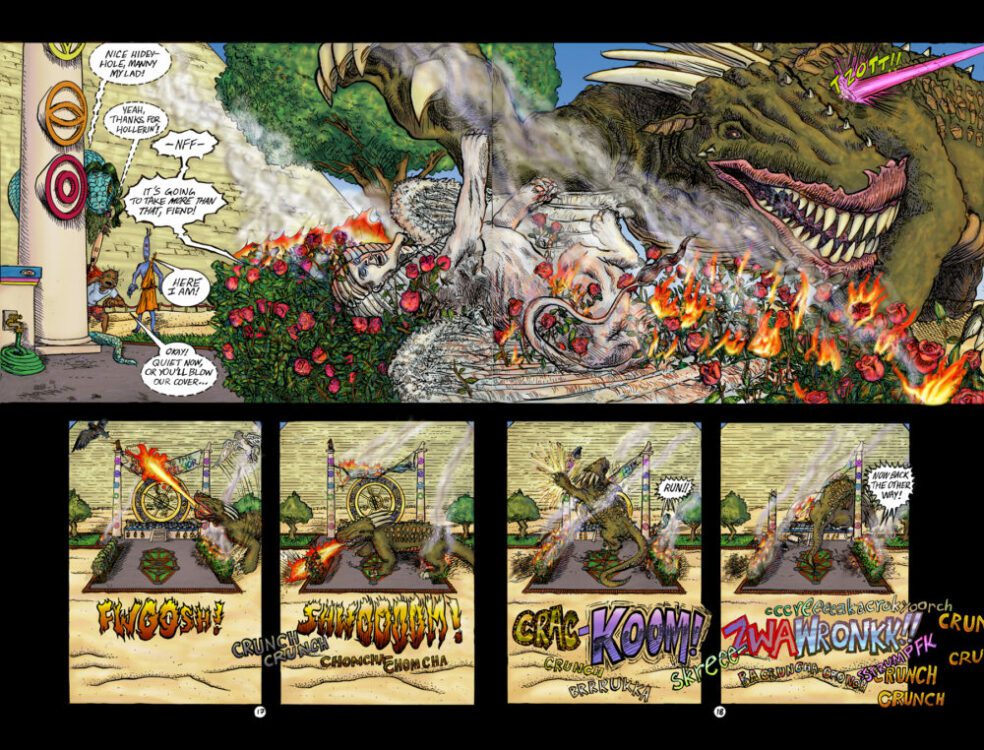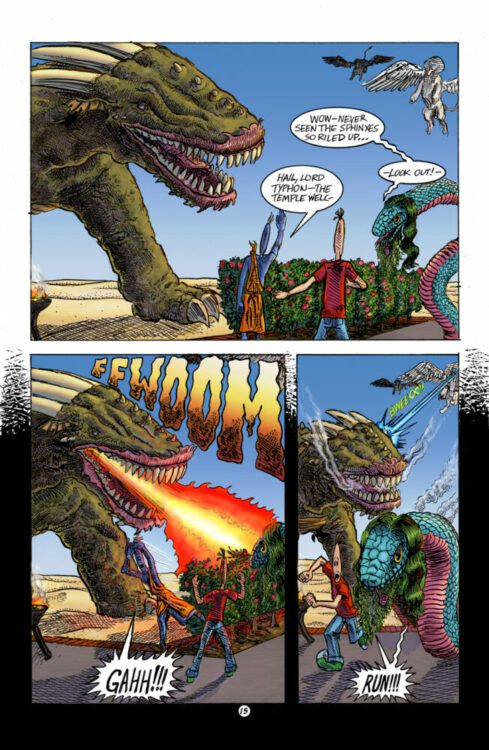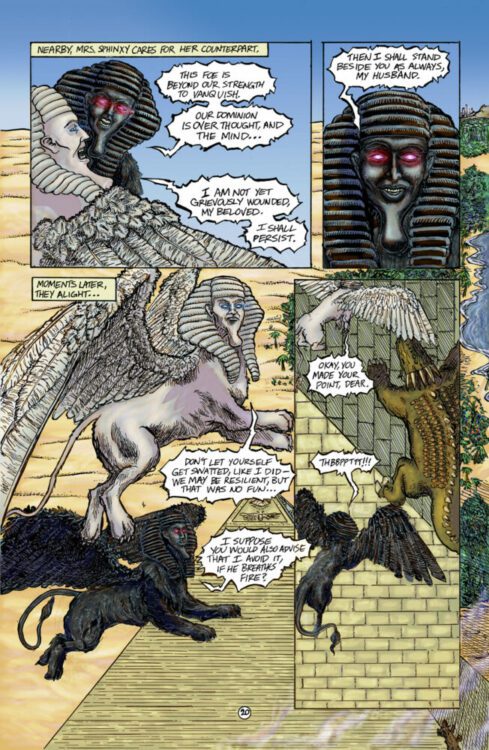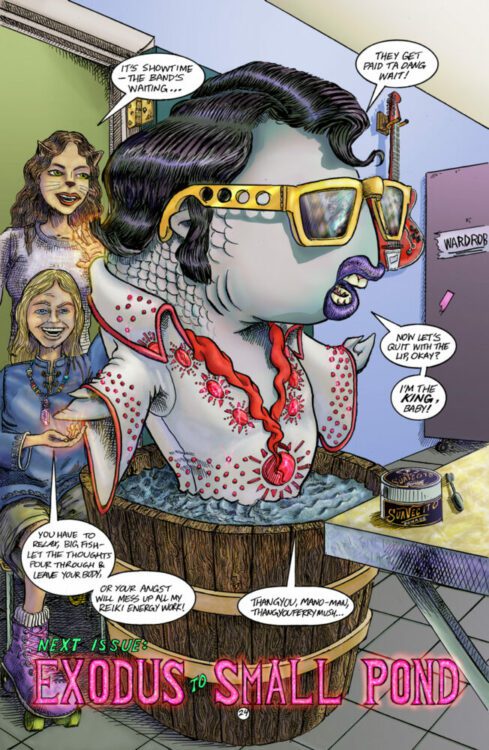Welcome to Self-Published Spotlight, a regular interview column where I will be highlighting self-published comics and the creators and small print publishers who make them.
When you read as many comics as I do it’s hard to find something that challenges you, seems totally fresh and makes you see comics and creativity in a new light. Sure I love a lot of comics, but sometimes even the best of them can sometimes be easily compared to something else or pitched in one sentence. The Transmigatory Adventures of Phillip K. In The Land of The In-Betweeners is not like that. It’s a book that really does defy category and genre, a description that can also be applied to its creator, Sam Tsohonis. I’ve never read a comic quite like this one nor have to a creator like Sam. His book is as awesome as he is. Reading it and talking to him were both trips completely worth taking. So read this fantastic chat and more importantly check out The Transmigatory Adventures of Phillip K. In The Land of The In-Betweeners, because you will not be disappointed!
Monkeys Fighting Robots: Sam, what’s your comic book origin? How did you discover comics?
Sam Tsohonis: The first stuff I got was off the newsstands, as a kid back in the 80s. First the occasional Marvel Star Wars books, and then GI JOE—which I was mostly into just for Snake Eyes and Storm Shadow. Then everything opened up when I discovered Wolverine. I think it was either Uncanny X-Men #239 or Wolverine #1 (the ongoing series) that I bought first, and I was hooked on X-books after that. I’d always been onto drawing, but that was when I first began to take the idea of developing the skills to do comic book art seriously. In high school I got into music, and I wanted girls to take me more seriously—and like a lot of fans who were reading comics at the time, I got a little disappointed after following my favorite creators over to Image, as the stories weren’t quite as good as they were at Marvel. But I was also disinterested in Marvel books, after all the Image crew had left. But mostly because I was associating my artistic impulse with my inability to get girls as a kid, I stopped reading comics and drawing for some time. Of course many of us still remember, society was fairly rough on comic geeks back then! I came back after somebody convinced me to check out Preacher. Then I became more interested in Vertigo books and stuff like that.
MFR ON YOUTUBE (latest video)
Help us reach 5K Subs!
MFR: Preacher is a goodone, it’s what brought me back to comics also.
ST: Yeah, it hits a lot of good spots!
MFR: When did you decide you wanted to create comics? Was there a specific moment or book?
ST: Yeah I think it was Marc Silvestri and Dan Green’s work on Uncanny X-Men, followed swiftly by Lee and Williams when they took over. I felt an immediate kinship to Silvestri’s style. It felt fast and furious, and he didn’t worry if a leg and foot were somewhat rough or suggestive. I see now that it helped me to access my own gestural energy when I was drawing. But soon I would be agonizing for a while as a kid over my inability to understand how to do the Lee/Williams feather-shading and linework, and trying to challenge my inner architect to surface, get things precise and clean and accurate—and that’s remained pretty strong, except for when I get bored or in a hurry. I can redraw a figure a million times before I settle on what I want. I also dug Liefeld and McFarlane a ton, and I was also checking out Ron Lim’s stuff. Sam Kieth was another big inspiration, though more for his rendering than the exaggerated forms he drew. I remember not liking BWS as a kid because he drew noses too long, which I saw as an especially embarrassing weakness because I’d already become aware that was a tendency I had, too. And Art Adams always felt like he was drawing action figures or something—and it’s funny because now those two are some of my favorite artists! I was an arrogant little kid! Like, I just stare and stare at Art Adams’ work, now. He has such a gorgeous style, the way he uses crosshatching with such subtlety and control…

MFR: When did you create your first comic?
ST: In college I started working on a postapocalyptic thing called Easterwest, which I ended up finishing 24 pages of in 2004. It was black and white, and I was smoking a lot of pot and the ink work turned out REALLY sloppy, while I remember having taken some real time to carefully draw the pencils. I think I got in a hurry to get it done and sorta ruined it. Then it was maybe five years before I gave it another go, and I did about 12 pages in color and sent it around but got no responses, and sort of gave up for a while to do some different creative projects. That was 2009. I still want to do that story, but since then ‘East of West’ has become a property, which is too close to Easterwest, so now I have a different title in mind. I started drawing Philip K a few years before I started working on those early Easterwest pages, though. Except I always thought it would be an animation. The first drawings I did of Philip K and his pals were in colored pencil in fact—I think I might get Sam J Royale to do a cover when it comes time to do the graphic novel compiling issues 1-6, because his style of rendering is actually really close to what I first envisioned, though I wasn’t really very skilled with colored pencils.
MFR: So currently you are at the tail end of a Kickstarter for issue #3 of your excellent comic, The Transmigatory Adventures of Phillip K. In The Land of The In-Betweeners. For those folks who haven’t read the book yet, what’s your elevator pitch for it?
ST: Well, it’s ‘Defending Your Life’ in Toontown. Basically a guy dies and he gets to this ‘other place’, a different reality so to speak, but it ain’t Heaven or Hell. and he’s ultimately working out the issues that affected him in life, but he has a sort of vague connection to what life was before—hence the sort of generic elongated smiley face he has.
MFR: From reading your backmatter in the first issue, I loved reading about the journey of creating the story as well. Can you share that with our readers?ST: Well, that really is a long story. In this first story arc I’m doing I’ve doubled down on the woo-woo stuff, but the original Philip K story in my head always involved him and a girl, and trying to impress her. Before it was really a story, though it was a song. I had a cassette four-track recorder in 1997, and my friend Jozef and I started recording tunes together in my parents’ garage under the name ‘Purr 17’. I had been drawing Philip and one day started making a song about him. I don’t think anybody else played on that four-track tune, even though it appeared on our first cassette release ‘Eunuch Dong’ and we played it live, the handful of times we played concerts. At that point it was just about ‘Philip in the Land of the In-Betweeners’. And in the original lyrics he’d actually killed himself, out of sheer curiosity about what happens when you die. It’s significant to issue 3 in particular because a big inspiration in my life at the time was this guy Pythagamus Toadstool (he’d legally changed his name), who’d introduced me to the Church of the Subgenius and a lot of other fun, weird stuff. He was also releasing lo-fi albums on cassette; had just moved to my hometown Wenatchee, from Los Angeles. I think I was reading the Book of the Subgenius when I first started drawing and imagining Philip K, and now the Subgenius mascot/figurehead J.R. “Bob” Dobbs is appearing in issue 3 as a character! Throughout college I was drawing Philip K in ballpoint pen a lot, and writing little entries in my sketch journal when I had new ideas about the plot. Most of the projects I did in the couple years of Animation studies I pursued in college featured Philip. Although on the first day of animation class at Evergreen, my professor Ruth Hayes told us all that while she was going to teach us how to animate our drawings, if we wanted to tell our own stories through animation we needed to learn how to WRITE. My undergrad career was a drawn-out smorgasbord of different creative studies, but I did take a significant amount of Creative Writing courses throughout the span of it. I would come back to it throughout my adult life, when inspiration hit, but it wasn’t until years after college when I finally wrote a couple of drafts of a screenplay for a full-length animated feature of Philip K—the first in 2014, when after ditching my failed graphic design career I was hopping trains and hitchhiking back and forth between Los Angeles and Albuquerque, and working for my bed in hostels (sounds like a story of ruin but the year was actually incredibly therapeutic). The original script barely has any resemblance to what has happened in issues 1-3, other than his trippy death sequence, the desert and meeting Big Fish at Small Pond. I think that all happened in the first 15 pages, in fact! And the only mystically- or spiritually-oriented figures he encountered were other tweens, who had no reference to the culture of the real world (or the Great Before-It-All, as it is known in the Between-Lifes). It was more about this princess who he’d become obsessed with, and whose only interest in him was to use him when it suited her. And a different girl he completely ignored, that was actually good for him. And a whole bunch of other cool, silly stuff. And while my intent is definitely to get into a lot of that content, eventually, I wanted to take more time if I was going to do a comic, and stir up the idea of ‘Gods and Heroes (and even fictional characters) walking among us’, and just give it a more mystical sort of foundation before delving into this other stuff, where he chases around a rather abusive and manipulative princess, and gets in trouble from her dad, and gets in trouble from Judge Knott, and the Council of wise Guys, and constantly has these red balloon manifestations harassing him and pissing other Tweens off. By the end of issue 6, my plan is to have him in a position where he can start having some version of the adventures from that script, and maybe by that point, I’ll be able to get the book with a publisher, and maybe pay some people to ink and color so I can get it out on a more regular basis!
MFR: One of the most interesting things that stood out to me was the juxtaposition of Phillip K., who I read as a very innocent and sweet character flung, violently I should add, into this bizarre world. That pairing works so well. Did you intend for Phillip to come across as innocent and if so, what made you make that decision?
ST: That’s definitely the case, although I hope to reveal greater complexity as the story goes on—like, the Meanie-Balleenies, these little red balloons that show up in issues 1 and 3, they’re manifestations of his anger, which he’s always bottling up for the sake of remaining positive. There’s a subtheme there that is sort of known to me, but I’m also letting it play out. He might find by the end of his story that he’s not as perfectly good as he thought, not that I would have that read as any kind of condemnation, or anything.
MFR: There is also a free-flowing, almost dreamlike path the narrative has. Do you use dreams or other meditative thinking to explore or help create your stories?ST: In my late teens and early twenties I spent a lot more time trying to meditate, and maybe during the era when I originally started drawing him I was having some kind of uncanny dream experiences that stuck with me. And since High School, I’ve been an off-and-on indulger in psychedelic substances (or Entheogens, as we say when we want to sound sophisticated about it), which have definitely influenced the way I perceive the world and its shape. Although I have been on a hiatus from that stuff, in hopes of opening up again to more significant experiences in dreams—sometimes I feel like maybe the two paths are at odds, you know, the path of augmentation or that of purely internal mystical self-reliance.
MFR: Also I love how Phillip K, with his elongated head, is a drastically different visual than any of the other humans we see in issue one. Was this always the case, for Phillp to, for lack of a better term, have a more cartoony look?
ST: Yeah, it was always my intent to have him like that and then to have all the other characters fill in the spectrum from realistic to their own version of cartoony. Some tweens are sorta boring and lifelike, not very changed from their original living form. And some are straight-up comical in the way they look. Sammy Sourpuss is a character with a lemon for a head, and he’s a bit of a wet blanket most of the time. There will be other characters that have a similar structure to Philip. the princess does, and then the apple of her eye—basically just a much cooler version of Philip named ‘Wavy Phil’. They should both show up, at least briefly, by issue 6 but they’ll play a big part of the story as it goes on from there.
MFR: Also I love that you include backmatter, letters from readers and process notes and art in the book. Not enough of that in comics. What made you want to throw that stuff in?
ST: I guess it’s just that self-indulgence one gets up to when they have finally put together a real comic book for the first time—I just wanted to have it feel like the trappings of all the comics I grew up loving as a kid. I hope to get more stuff like pinups from other artists, etc, but the last year has been economically challenging to me, to say the least, so I couldn’t really solicit any of that. I’m a bit bummed that I didn’t receive any letters from issue 2, but I’ll write something on that letters page, all the same. Issue 3 will have a couple character sketches I did of Z-Ra and Mano-Man, who cameo in the end of issue 2 but play a bigger role in 3. They’re actually based on my friends Chelan and Israel’s kids up in Seattle. Chelan backed the Kickstarter of issue 2 with the option to have a character appear based on somebody from life, so they’re astrally projecting into the Between-Lifes. And I’ve been sending comics to Dave Sim to get his take, and he responded to a drawing I sent of Philip and Cerebus hanging out together with his own drawing of the two, so that will also appear. I’m not very closely aligned with a lot of Sim’s takes on the world, but I was definitely inspired by some of the earlier Cerebus stuff when I started envisioning Philip K, so to have a drawing of my character by one of the most accomplished indy creators of all time is pretty exciting.
MFR: Speaking of process, what is yours? How do you put pen to paper? Is it digital? Analog? What tools do you use?
ST: presently I’m doing pencils and inks of linework and lettering on paper, and then coloring in Photoshop. I have this 13″ XP-Pen tablet hooked up to a 2010 Macbook stuck in El Capitan (which is maybe getting ready for the glue factory), and there are some buggy-ass things that tablet does, but so far I’ve made it on the gear I have. I got in a hurry with issue 3 so I didn’t pencil as thoroughly as I wanted to but with issue 2 I really took time going through drafts of pencils, beginning with thumbs and then roughs at comic size, and then a final set of pencils on 11×17 printer paper. For each stage of the pencils I would scan in, render in blue line, print out on the next size and tighten pencils in graphite over the blue. And finally, I printed the final pencils onto the Strathmore 11×17 bristol for inking. I REALLY liked the way inking went with that because I have a hard time keeping the page from getting messy with pencil smears and half-erased lines. It was the most aesthetically pleasing inking experience I’ve had to date. It does suck though that an issue of blue lines seems to go through an entire Cyan cartridge in my Epson WF-7280. For Inking, I’m mostly using a Hunt 102 nib, and a pentel pocket brush for fills. I use a lot of the ’10’ size white gel roller pens that are out there, but the smaller sizes never seem to work like I want. I’ve also gotten into using a brush with DR Martens pen-white but I only like to use that as a final touch, as it doesn’t take a crowquill very nicely at all if I want to run black over it again. I’ll probably get some white acrylic paint at some point, as I gather that’s where a lot of artists end up with the quest for the right white media.
MFR: Let’s get into issue three. What can we expect? And did anything change in how you created each issue, especially this one?
ST: Well, like I said I got in a bit of a hurry with this one. Some of the pencils were somewhat loose this time, and I did them live on the final inking surface as opposed to the method I described from issue 2. And I used crow quill to letter instead of a micron—I just end up erasing too much when inks are down to use tech pens, they almost inevitably get half-erased and need to be redrawn when I use them. As far as content, there are a lot of dead celebrity cameos, and a lot more characters interacting in general. I reread issue 1 and it feels very slow and still, compared to what I’ve been doing since. But I sort of wanted that feeling for the beginning, when he’s wandering the desert. I think it will make the collected version of 1-6 read with a more dynamic sense of pacing. Even though the pencils were looser I think I did even more detailed rendering in much of the inks, and in general issue 3 seems to continue the trend of tightening up the art, as I’m finding my real style and flow as a comic illustrator.
MFR: What’s the status of the new book? I know the Kickstarter campaign just hit its funding, so congratulations on that. But where are you as far as the creation of the book?
ST: I’m coloring it now, with the goal that by the time I see the money in my account it will be ready to send to the printer—I’ve come to the point where that seems a workable point from which to launch, although I think my Kickstarter campaigns could look flashier if I had color images of the pages to share! I might still be coloring another week or so after the campaign ends, realistically, but I don’t probably have to tell your readers what a slog it is doing every goddamn piece of the work yourself! I try and keep a regular routine going on but I must admit allowing myself to get distracted by what I have playing on the TV sometimes. I think I’d go a little nuts if I didn’t have that going, though—It’s funny because when I write, I just like to have instrumental music in the background, and I can go for hours on end that way, but when I’m drawing I really crave that narrative content on a screen, even if I’m not looking at it.
MFR: And finally, where can people find your work outside of the comic?
ST: I’ve done a lot of different stuff over the years, but only so much of it is very available to view. The main thing is, people should check out the issue 3 Kickstarter here—there’s also some original art for sale at my portfolio site, tsohonis.com (and you can find links there to other stuff I have going online) and back issues of Philip K for sale at mnemoniccomics.com.


